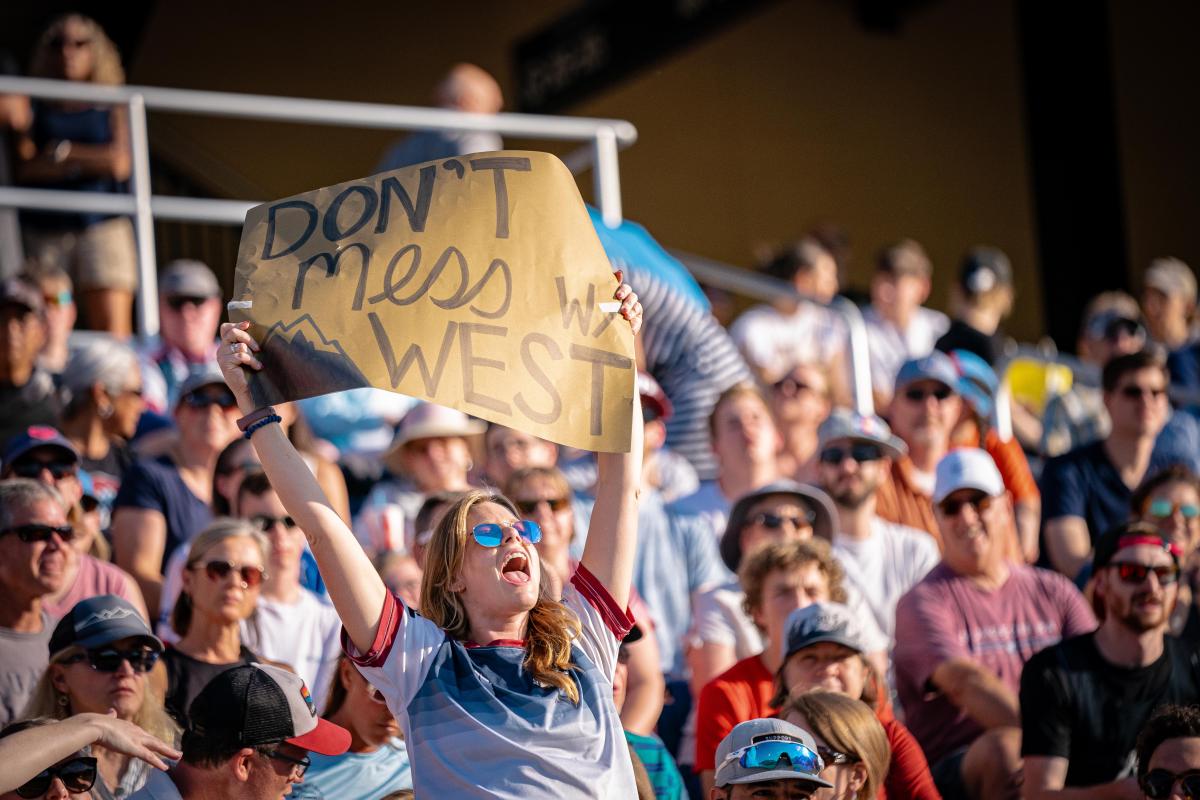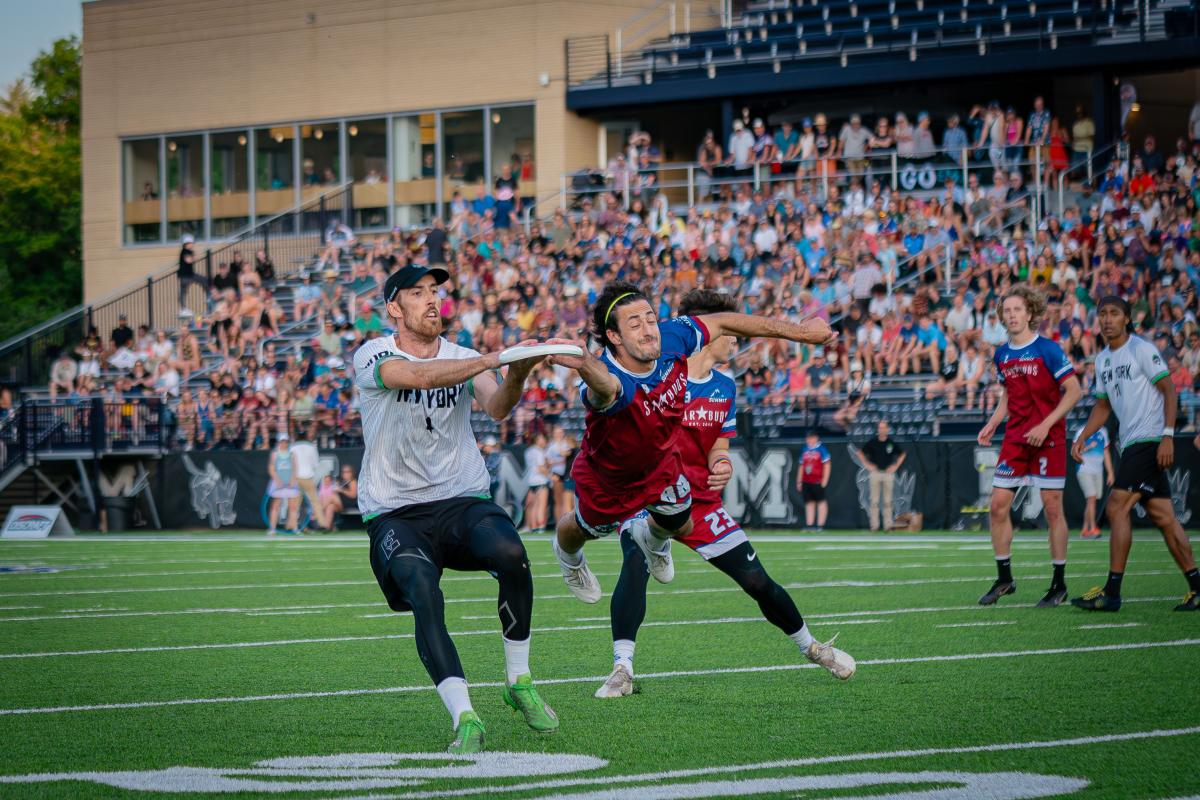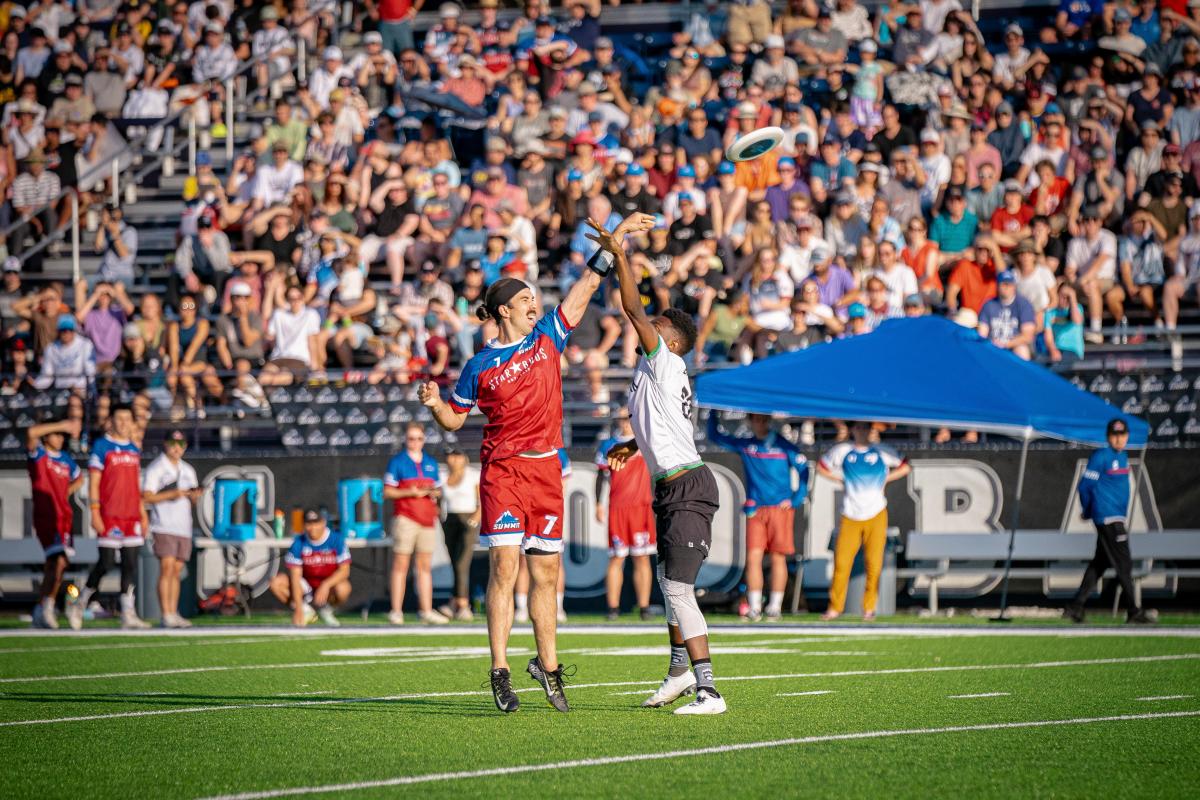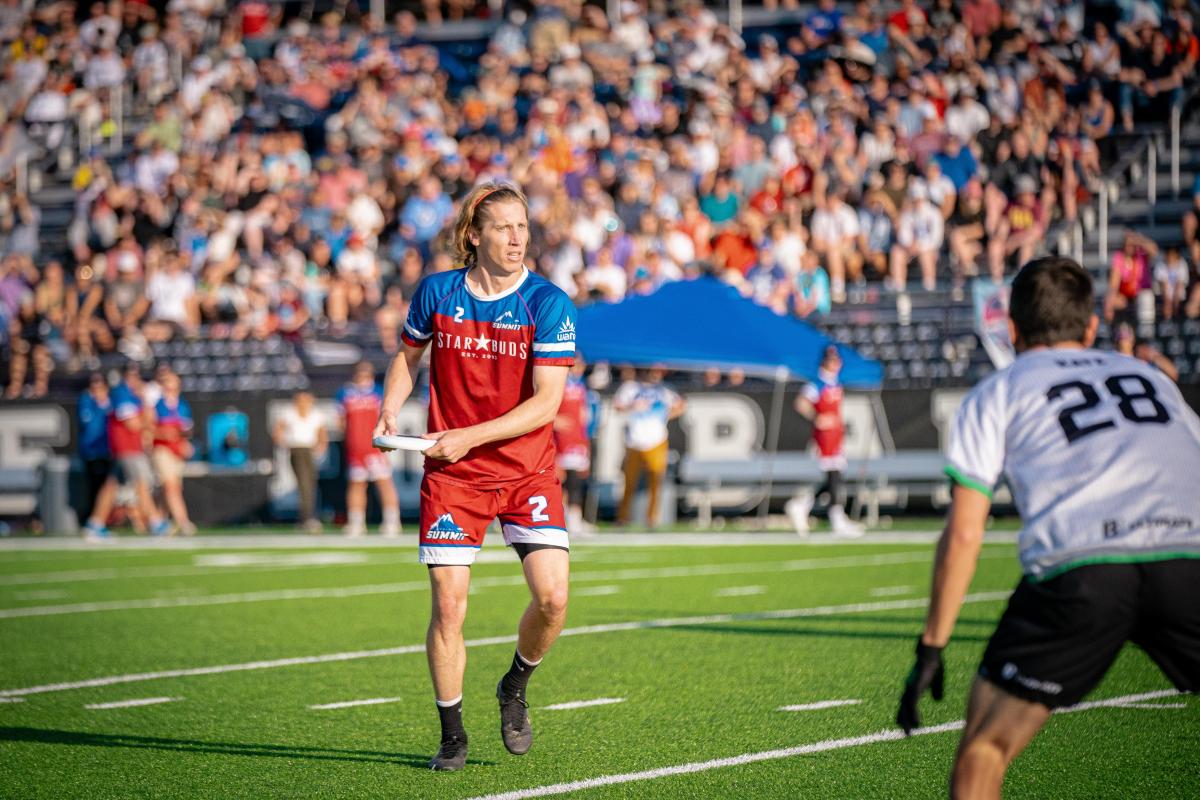
July 28, 2023
By Evan Lepler
After 144 regular season battles, we’re down to the last 11 elimination contests to determine the 2023 AUDL Champion.

There’s no question that New York’s the heavy favorite, and the Empire are certainly chasing history, trying to be the first franchise to ever win three titles, along with looking to match the league’s all-time record for longest winning streak. Another New York championship would mean the Empire enter 2024 on a 30-game heater, which would match the Toronto Rush’s best stretch from their early years in the league.
But the Empire are not without threats to their reign.
The Salt Lake Shred know they can compete with New York. Despite losing by four in their interdivisional thriller on July 15, the Shred can point to a small handful of game-changing unforced errors that, if corrected, could easily transform a three or four point game into one that’s decided by just one or two. With additional confidence gleaned from sharing the field with the champs in Week 12, Salt Lake has its sights set on a rematch.

The Atlanta Hustle might actually be the Empire’s toughest interdivisional matchup because of their considerable collection of size and speed. They also played New York within three on the road AND on the second day of a back-to-back when they met on June 10. A potential rematch between the Hustle and Empire, if it were to materialize, would come on Championship Saturday, one night after both have successfully navigated semifinal battles.
Of course, the DC Breeze have been knocking on New York’s door for a couple years now, and one definitely could envision parallels toward 2018, when the Rush looked like a clear and obvious favorite, only to get stunned at home in the East Division finals. The Breeze are definitely underdogs in that game, but they clearly have been relentlessly competitive with the Empire. At some point, after enough pressure, the latch is gonna break.
And let’s not forget that the Carolina Flyers are the last team to actually defeat New York, back in the 2021 Championship Game. Now, that did require perhaps the greatest single-game ultimate performance in AUDL history, when the Flyers managed to only have seven turnovers (including the celebratory throwaway at the buzzer) in a masterful 19-16 victory. The Flyers have a long road ahead just to get another crack at the Empire, but if Carolina could somehow string together wins at Austin and Atlanta, their ceiling of high-level ultimate absolutely could challenge the league’s greatest dynasty.

Meanwhile, the AUDL playoffs begin this Saturday with four battles between teams that finished second and third in their divisions. And beyond all of the intriguing matchups, the thing I’m most interested in seeing is the Colorado Summit offense.
When we last saw the Summit take the field, their offense was, to be frank, kind of a mess. For the first time in franchise history, Colorado’s O-line held on fewer than 50 percent of its chances on July 14 against the Empire. Yes, the New York defense created significant pressure, but the Summit offense often looked disconnected and indecisive.
After that game, one of my main takeaways was that the Colorado offense was in the midst of an identity crisis.
What do I mean by that? Well, for starters, it wasn’t clear to me whether the O-line knew who their top weapons were and what they wanted to do. There’s no question that they’ve got an incredibly talented collection of individuals, however the pieces were not consistently and reliably all on the same page.
“It comes down to a couple of things,” said Colorado Captain Quinn Finer, asked about the offense’s struggles immediately after the New York game. “We’ve been swapping a lot of O-line players, and I think we just haven’t had a group where we felt cohesive, just because of injuries and people absent. So we’ve been adding players, subtracting players constantly. I think once we find a group that we can roll with, we’re gonna be golden.”

Since then, the Summit have had two weeks to tinker internally. And they’ve had plenty of decisions to make, the consequences of which will likely determine whether Colorado can easily surpass Los Angeles on Saturday.
Among the myriad of issues, from my vantage point, are 1) figuring out the dynamic between Jonathan Nethercutt and Alex Atkins, and 2) deciding whose role must shrink or disappear to allow Danny Landesman and Calvin Stoughton to make a positive impact in the playoffs.
Let’s start with number one.
With Nethercutt’s struggles and lack of availability for Saturday’s postseason opener against Los Angeles, the Summit have decided to move him off the team’s O-line for the rest of the season. It’s a bold choice, one that could create the right chemistry or could leave an MVP-sized hole on the unit.
Clearly, Nethercutt, a former MVP, is a dynamic thrower and authoritative presence at the helm of the offense. He threw 37 assists in seven games, but also had multiple turns in all of them. He completed 17-of-30 hucks, a good but not great number for an offense that wanted to become more possession-oriented and less huck-happy. At age 31, he might be a smidge past his peak athleticism, but he’s still competitive as a defender on a turn.

In many ways, the 24-year-old Atkins is a younger, more dynamic version of Nethercutt, capable of quarterbacking the attack, but also at his best making explosive plays in the air. When Nethercutt was out during the team’s road trip to Salt Lake and Oakland, Atkins completed 135 passes in two games, illustrating how he can be an every-other throw type guy. He’s also not scared to launch it long, completing 19-of-27 hucks in nine games on the season.
Finer’s immense abilities also must be a major factor for the Summit, and the 25-year-old hybrid warrants a significant role in how the Summit offense should churn. Though his numbers were not quite as eye-popping as last year, Finer still had 60 scores, along with 31 other hockey assists, and completed 24-of-31 hucks in 12 games.
Looking at the rest of the O-line, Jay Froude and Matt Jackson are two tremendous veterans who’ve enjoyed phenomenal careers in this league, but they presently are players that, at 33 and 34-years-old, respectively, are lacking the ultra-elite explosiveness that defined their primes. Against the Empire, aside from one throw-back-the-clock skying score from Froude, they were marginal factors in the Summit’s attack. In fairness, both have dealt with nagging injuries, so that’s the caveat in case either turns back the clock and goes off on Saturday night.

The other duo on O-line two weeks ago was Sam Goldstein as Nethercutt’s back-field mate, a reliable but not super explosive reset handler, and Connor Olson, who’s endured a season of role-searching in his first year with the Summit, just one year removed from tearing his ACL.
Which brings us to the second factor, the return of Landesman and Stoughton, two dudes coming off Team USA U-24 gold medals who played a combined four games during the AUDL regular season. Are they truly gonna be the difference going forward?
That’s what Colorado’s hoping for, believing that past chemistry, broad skillsets, and a strong systematic understanding will pave the way for plenty of clean holds. But it’s still not quite that simple.
Who’s going to make room for them? Will Goldstein seamlessly shift back to D-line and be a positive factor for the Summit on that unit? Will Colorado keep all three of the Froude-Jackson-Olson group on offense, or might they move one of those guys to a new role too? Remember, Jackson played D-line the opening weekend of the season before moving back onto the offense. Froude’s top 20 all-time in blocks in AUDL history. Olson’s played D-line 48 percent of the time in his career. All three of these individuals could potentially give the defense a boost while creating more space for others on the offense.

When asked if Atkins will be the new primary center handler to initiate most possessions, Summit Co-Coach Tim Kefalas explained that Colorado is not looking for a single person to be in that role.
“I don’t think we want a QB1,” said Kefalas. “I think everybody on that line is a dynamic player with good speed and athleticism, and I think we can cycle a lot of folks through there.”
Regardless of who distributes the first downfield pass every possession, the new-look Summit O-line will very much revolve around Atkins and Finer, as the Summit have undeniably been more efficient and explosive when that youthful duo is making the bigger throws and more pressure-packed decisions. Ideally, you would want both those guys beginning points downfield, capitalizing on their still-evolving statures as two-way threats, compared to just keeping Atkins behind the disc and using his length as a free reset. If Stoughton can continue his playmaking—13 goals and five assists in three games this year—that gives the Summit another dangerous and dynamic downfield weapon, with Landesman as useful hybrid option too.
Unquestionably, the Summit have spent the past 14 days studying, contemplating, and planning for their biggest games of the season. This is the time of year that will define whether Colorado can actually reach their full potential, or whether they will lose their status as the ‘defending West Division Champs.’
Remember, in the preseason, I picked the Colorado Summit to win the title. That’s how highly I value their talent, depth, and coaching staff. Three straight one-goal losses after a 5-0 start threw everyone off the scent, and an underperforming offense offered confirmation bias to anyone who suggested that Colorado were no longer a true contender.
But the playoffs are a time where many old narratives are smashed to smithereens. New perceptions and enduring legacies are always dictated by how a team fares when it’s truly do-or-die. Come Saturday night, and maybe beyond, we’ll see whether the Summit can indeed rise up again.







